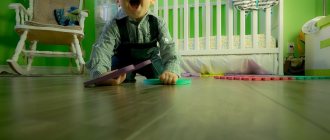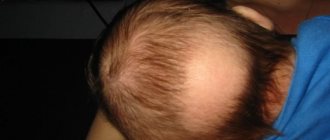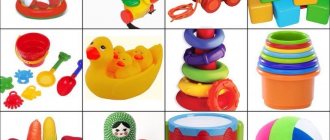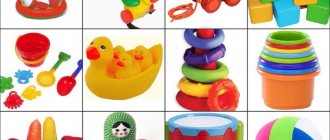Today, all mothers know very well that fine motor skills in children need to be developed almost from birth.
Another great Soviet teacher-innovator V. A. Sukhomlinsky said that the child’s mind is at his fingertips.
Today, all mothers know very well that fine motor skills in children need to be developed almost from birth.
But not everyone has an idea of how to do it correctly, and in general, what is fine motor skills and what are its features? Let's look at these questions.
Features of fine motor skills of children under 1 year of age
Fine motor skills develop from the moment a child is born and play a huge role in the overall development of the baby. First, the baby looks at his hands, then learns to use them - he clumsily takes objects with his whole palm, then only with his thumb and forefinger, and only, having gone through all these stages, begins to take the toy the way adults do. A little later, the mother teaches the baby to hold a spoon, pencil, and paint brush in his hand.
Fine motor skills have one very important feature
- it is closely connected with the nervous system, attention, memory, vision and perception of the child. Scientists have long proven that early speech development largely depends on the development of fine motor skills in children. From a scientific point of view, this can be explained simply: the speech and motor centers in the human brain are located very close.
When stimulating the motor skills of a child’s fingers, his speech center begins to become more active—that’s why, for timely speech development, more attention needs to be paid to exercises to develop motor skills of the hands and fingers. This will affect handwriting, manual dexterity, and reaction speed in the future.
Fine motor development calendar
How much should a child gain?
The brain, speech organs (lips, tongue and lower jaw) and movements of the fingertips are interconnected. If a child exhibits lethargy, uncertainty, and stiffness in the actions of his hands and fingers, then, as a rule, his speech and writing will lag behind at school age.
To avoid this, there are special calendars for the physiological development and behavioral skills of a baby from birth to 4-5 years and older. Some of them help to identify whether the development of fine motor skills is impaired, and also offer simple test exercises (diagnostic). Others list the actions that children should be able to perform at a certain time period, for example, during the first month, the first year (monthly), from 1 year to 5-6 years. Each calendar includes features of behavioral skills at a specific age.
Such calendars help to understand how to develop a child’s fine motor skills. Below is an example of a table for the development of a child’s finger motor skills from birth to age 6. Of course, not all activities are included in this calendar, but it can give a general schematic picture of the dynamics of the formation of fine motor skills.
Fine motor development calendar
| Age | Fine motor skills |
| 0-4 months | The child learns to move his arms and legs, develops reflexive grasping movements, and turns his head towards his mother’s voice. |
| 4-12 months | Can hold an object with one hand, examine it, reach, take, transfer from hand to hand. He can kick a ball with his foot, hold a spoon with his hand and bring it to his mouth. |
| 1-2 years | Sits confidently and plays with both hands. Holds a pencil or spoon with the whole hand, fingers work actively. Can draw circles and lines, break plasticine, and crush it with his fingers. |
| 2-3 years | Determined with a dominant handle (“right-handed” or “left-handed”). He begins to hold a pencil with his fingers and come up with drawings on his own. Learns to cut a sheet of paper with scissors. When sculpting, the palms and fingers are used. Confidently makes mosaic drawings or puts together simple puzzles. |
| 3-4 years | By the age of 4, he holds a pencil with three fingers. Creates complex drawings, sometimes even copying them from books. Cuts with scissors in a straight line more confidently and accurately. He sculpts animal figures and objects with his fingers. |
| 4-5 years | Begins to draw and color pictures confidently. Can cut squares and circles. |
| 5-6 years | All acquired fine motor skills are improved, preparing the baby for school. |
Why do we need activities that develop fine motor skills?
Often, the development of a child’s fine motor skills is used to judge his readiness for school. It is believed that if everything is in order with it, then the child can reason, think logically, is prepared to learn to write, has good concentration, memory, imagination, attention, and oral speech.
Each child develops fine motor skills individually. At first, the movements of the handles are still inept, awkward and inharmonious. To help the baby develop in this direction, many modern techniques, educational games and exercises have been invented.
Fine motor skills in children from 4 to 7 months
At 4 months, in accordance with the norms of child development, the baby usually holds the rattle tightly, can shake it, put it in his mouth and even transfer it from hand to hand. At the age of 4 to 7 months, the child uses his palms as claws or a rake, that is, he lifts objects of interest to him with a raking motion. The baby can also grab an object with one hand, transfer it to the other, and make a rotational movement of the wrist towards himself in order to examine the thing.
How to develop hand motor skills in a child from 4 to 7 months
What can be done for the development of a child at this age:
- Place toys at some distance from the baby so that he has an incentive to reach for them.
- Let him play with blocks and stuffed animals to develop his hand-eye coordination.
Summarize
| So, a baby between the ages of 4 and 7 months usually develops the following elements of hand motor skills: ● He can reach for objects with one hand. ● He transfers objects from one hand to another. ● He can lift objects using a raking motion with his palm. |
When should you worry?
There is a certain list of what a child at 9 months must be able to do:
- sits without support for up to 10 minutes;
- crawls or tries to crawl;
- stands on his feet against a support or makes his first attempts to do so;
- holds a mug with both hands;
- distinguishes his loved ones from strangers;
- reacts to his name.
If these skills and actions are not available, consult a doctor.
The child's development at 9 months is also assessed by a neurologist. If there are any problems, he will definitely tell you how to solve them.
Exercises for fine motor skills
Development from 0 to 2 years:
- White-sided magpie (bend your fingers and say a nursery rhyme);
- Ladushki, clappers (clap your hands);
- Hide and seek (cover your eyes with your palms);
- Bunny (move fingers and ears);
- Hello fingers (say hello to each finger);
- Strong fingers (clasp, slightly bending, fingers together).
Development from 2 years:
- Fisherman (catch small objects with a spoon in a plate);
- Path (sprinkle a path, circle, triangle from any cereal);
- Sweet tea (put sugar and stir in a mug);
- Salute (tear a sheet of paper into small pieces and throw it above you);
- Lump (crumple the paper into a lump);
- Collect (put sticks, buttons, beads in a box);
Development from 3 years:
- Labyrinth (draw and teach your child to find the right path);
- Beads (start with bagels, then pasta, buttons, beads, seed beads);
- Path (draw a winding line, let the baby follow it);
- Figures (cut out various figures and glue them onto a sheet);
- Gift (wrap a small item in several wrappers and ask to unwrap it);
- Clothespins (we teach you how to use them);
- Treats (made from plasticine).
When to start working with your baby
How to remove hair from a newborn's ears
There is no point in talking about at what age to start classes for the development of motor skills, because the baby is engaged in this from the first days of life. At first, his movements are chaotic, his fingers clench and open impulsively. Already in the second month, you can help the baby develop grasping movements (give your finger, a round ring rattle). Only by 3-4 months, when the child begins to concentrate his attention and gaze on objects, toys and arms or legs, can you help him. How to conduct these trainings to improve a child's fine motor skills?
For the effectiveness and benefit of classes, parents must follow several rules:
- conducting them is interesting;
- emotions are only positive, the voice is quiet, calm;
- training should be short so as not to tire the baby;
- praise, even a baby (he will feel it by the intonation of his voice);
- conduct classes systematically.
Only by arming yourself with these simple requirements and fulfilling them, you can successfully conduct such classes at home.
Training exercises for the development of children's fine motor skills
How to develop a child's fine motor skills
Parents should take into account the age characteristics of their children. It’s hard to imagine a one-month-old baby with plasticine or a six-year-old with a rattle.
- Age 1 month. Massaging your hand and fingers will be the first step.
- Age 3-4 months. Babies of this age already have a well-developed grasping reflex. Use rattles made of different materials for his development: plastic, wood, fabric, stone, so that the baby receives different tactile sensations from touch.
- Age 6 months. By this age, the baby can already sit down independently and explore the objects around him with his hands. Special mats, where parts are selected in different colors and shapes, help well in development.
- Age 9-10 months. At this age, the baby gets up and even walks independently. All the things around him help in his development. Developmental centers have been created especially for this age group. They develop the following movements: turning, pressing, twisting, pulling, knocking.
- Age 12-24 months. At this age, you can play various finger games, nursery rhymes, and songs with movements with your baby. It is also very important at this age to begin to develop basic self-care skills.
- Age 2-4 years. The age of “myself”, the formation of personality. More complex development mechanisms are needed: modeling with plasticine and dough, drawing with paints and pencils, cutting with scissors, applique.
- Age 5-6 years. Fine motor skills of this age can fully cope with the basics of writing: circling dots, connecting numbers, writing letters and numbers.
What toys will help with development?
There are toys that a child can play with at any age. The older the young tester and the better developed fine motor skills of the fingers, the more interesting the applications for toys are:
- Constructors and cubes. Kids first learn the shapes and sizes of parts by touch and tooth. Afterwards they learn to build towers and castles. The cubes can be used as substitutes for a table or chair for the doll. The parts of the soft construction set are connected using Velcro and develop the flat and three-dimensional perception of the resulting figures.
- Inserts and frames. Matryoshka dolls, sorters, cups, logic cubes - all representatives of this type of toys will help your baby expand his horizons. They come in different sizes and shapes. To begin with, 2-3 elements will be enough, but with age you need to complicate the task and add more items.
- Magnetic figures. This type of toy allows you to collect a collection of letters, geometric shapes, and pictures of your favorite cartoon characters on your refrigerator. Children really enjoy arranging the figures and changing their places on the surface. For a grown-up fidget, suggest assembling a drawing on a magnet from several parts.
- Puzzles. The little ones will be interested in large wooden puzzle pieces that are placed in special cells. Afterwards, the pictures should become more complex by dividing them into several parts. More complex puzzles have a large number of fragments with a decrease in the size of the pieces.
- Laces. These toys come in different shapes and complexity. Mastering lacing toys helps a child master the skills of tying shoelaces.
- Mosaic. This game consists of different sizes and shapes of parts and a field on which these parts are lined up. From the beginning, you need to teach your child to put the parts in a line, gradually giving more and more new tasks.
- Finger puppets. Theatrical performances with the help of toys in the parents' hands initially entertain the baby. By imitating, the child grows and shows performances himself, mastering gestures, manners, and intonation.










